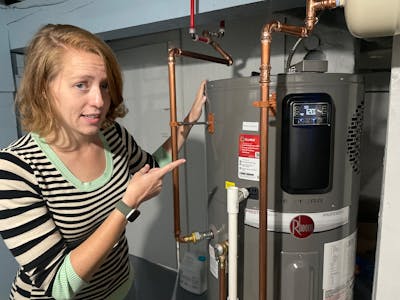TThose old clothes may look like garbage to you. But some of the leading local secondhand clothing sellers still want them, even with broken zippers or gaping holes.
"Some people worry if it's really pilled or really faded, should I donate it?" said Nick Adams, senior director of Goodwill's 47 retail stores in Minnesota. "Yes, absolutely do."
By some measures, the apparel industry is responsible for more greenhouse gases than aviation and shipping combined. Fast fashion is making it worse, with people buying and discarding clothes more frequently. Decomposing clothes produce methane, a far more potent greenhouse gas than carbon dioxide.
Goodwill and the Salvation Army put less than 1% of donated clothing in the landfill, Twin Cities-based leaders for both organizations say. They manage to sell most of it, pricing the shabbier clothes lower than the pristine donations. Some is sold by the pound.
Or, along with any other items that don't sell, some of it is packaged up into clothing bales that are sold to third-party vendors. The items are then used either domestically or overseas, where they are recycled or upcycled into things like rugs or cleaning rags, or are repaired and resold or donated.
Goodwill won't throw away any donated clothes unless they are wet or soiled, said Adams.
"Virtually all clothing, shoes, purses, boots, hats — all that kind of stuff — 99.99 percent of it we recycle or resell," he said.
Still, that doesn't mean some of the stuff couldn't eventually end up in a landfill, perhaps somewhere in Africa or South America. But thrift store leaders note that the items are given another chance or two or three to be reused before then.
The Salvation Army sells about 320,000 pounds of clothing a month in bales, which adds up to about 3.8 million pounds a year that's kept out of the landfill, said Tom Canfield, director of the Salvation Army's 11 thrift stores around the Twin Cities.
"We want it all," he said. "We want every bit of clothing that the community can give us."
YOUR CARBON FOOTPRINT
On this Earth Day, the Star Tribune offers a guide to the many ways you can take action today to reduce your carbon footprint.
If you're unsure whether a store will want something, bring it in and let the store decide, said Greg Rue, director of Arc's Value Village's three thrift stores in Richfield, Bloomington and New Hope. With slightly damaged clothing, if it's something that is trendy, stylish or vintage, Value Village will save it for its "autumn retro collection" sale, when it discounts items. It also sells its unsold clothing to third parties.
Each thrift store has its own standards for what it will accept and what it deems good enough to go on the sales floor. At Value Village, about half of clothing donations are offered for sale in its stores, Rue said. At Goodwill, it's a "large majority," said Adams.
After that, anywhere from 60% to 80% of the stuff put out on the sales floor sells, according to leaders of the largest nonprofit thrift store chains around the Twin Cities.
Clothing has the biggest thirdhand market, so secondhand stores are generally more liberal in what they will accept in that category. When it comes to other items, they do their best to turn away items at the point of donation that they can't resell or easily recycle, particularly large, heavily damaged furniture or things like paint or older-style TVs that are expensive to dispose of.
When it comes to electronics, small appliances and other household items, thrift stores generally prefer donated items be in working condition. But there is some wiggle room, since some parts of such devices can be broken down and sold to recyclers, such as metal, plastic, electrical cords and wiring, before the other parts are discarded.
"You might have a pan that's dented or the Teflon is coming off," said Rue. "You might not have an easy way to recycle that, but we can gather those items and then bring them to a recycler."
He added that Value Village doesn't want to get huge loads of damaged items, but they're happy to take a dented pot or two along with other donated items that are in good shape.
In addition to recycling some unsold items, the Salvation Army has a last-chance option, where other nonprofits can grab items for people in dire need. Older or lightly damaged furniture, for example, can be repaired or repainted by participants in its adult rehabilitation program, and then offered for reuse.
The Salvation Army has also recently started sending glass and other breakable items that it would otherwise throw away to the WreckIt Rage Room in Savage, where people pay to smash things.
Indeed, some thrift shops have become quite innovative in finding ways to resell or give away unsold items. Goodwill, for example, will send unwanted luggage and other bags to the Transportation Security Administration, which uses them for training.
But there are some things it's hard to find a way to repurpose or recycle, such as broken or chipped glassware and things like old phone cases and VHS tapes. These often end up in the trash.
"Throwing it away is the most expensive, worst thing for our mission and the environment that we can do," said Adams. "It's a last resort for us."
Emily Barker, executive director of the nonprofit Reuse Minnesota, noted that there are other options for broken or damaged items, such as Fix-It clinics, where volunteers help residents troubleshoot and fix items such as lamps or vacuum cleaners. Most counties in the metro area hold such free clinics either monthly or quarterly.
"They have a pretty good success rate," she said — they're able to fix about 80% of the things that are brought in.
Reuse Minnesota also holds mend-it clinics every month where they do basic repairs on clothing and other textiles such as backpacks.
For other items that are damaged, or things like games with missing parts, Barker recommends offering them to your local Buy Nothing group — someone else might have the other parts.
"Or maybe they want to repurpose it for some creative use," she said.











